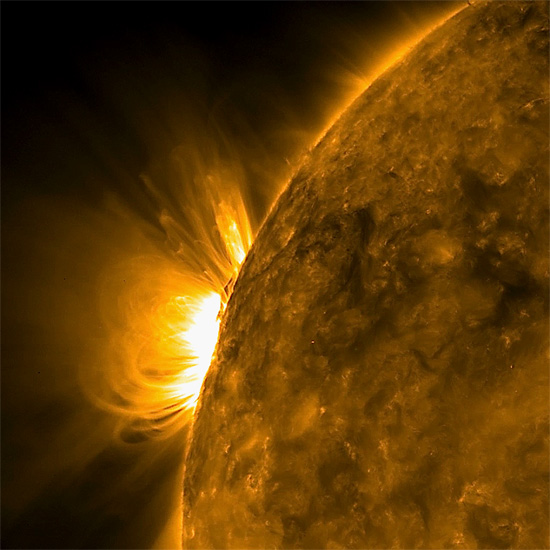|

by Stephen Smith
June 21,
2021
original
post June 21, 2012
from
Thunderbolts Website

An exploding double layer on the Sun.
Otherwise known as a solar flare.
Credit: NASA/Goddard Space Flight Center
Is it the breaking and reconnecting of magnetic field lines that
power solar phenomena?
According to a popular view of the Sun, its core pressure is
supposed to be so high that it crushes hydrogen atoms together until
they fuse into helium atoms, releasing energy of such magnitude that
Earth, 148 million kilometers away, is bathed in life-giving
radiation.
The Sun's core is thought
to be more than 15º million Celsius, and greater than 340º billion
times Earth's atmospheric pressure.
Above the photosphere, the part of the Sun that is seen, the
chromosphere extends for
thousands of kilometers. Above that, the corona extends for millions
of kilometers.
One of the greatest
mysteries about the Sun is why the photosphere averages 6000º
Celsius, while the corona can be as much as two million Celsius!
Why does the hottest
region of the Sun begin at an altitude of 4000 kilometers, extend
over a million kilometers from its surface, and show no sign of a
significant temperature drop?
Some heliophysicists propose that the "rearrangement of magnetic
field lines," otherwise known as "magnetic reconnection," causes the
heating.
Satellite observatories,
such as
SOHO (Solar and Heliospheric
Observatory) and
TRACE (Transition Region and
Coronal Explorer) have detected small, rapidly changing magnetic
regions on the Sun's surface.
Consensus viewpoints see
that activity as proof that reconnection events are heating the
solar corona.
What is magnetic reconnection?
Briefly, magnetic
field lines in a plasma are said to "break" and "reconnect".
Since solar plasmas
are complex systems, how those lines break apart and come
together again, releasing enormous amounts of light and thermal
energy, is not well understood.
That lack of
understanding is not surprising to Electric Universe
advocates because no one has ever seen magnetic field lines
reconnecting.
According to the author
of
The Electric Sky, Donald E.
Scott, no one ever will.
The Sun behaves according to the laws of electromagnetism and is a
positively charged electrode in a circuit that spans the Solar
System. The negatively charged electrode to which the solar energy
moves in that circuit is located far beyond the planets, nearly 100
times the radius of Earth's orbit.
That "virtual cathode" is
known as the heliopause.
The electric model sees sunspots, solar flares, coronal heating, and
all other solar activity as fluctuations in the amount of charge
flowing into the Sun.
That electric current
arrives in the form of plasma filaments that are gigantic in scale.
They are extremely
diffuse, but are so large that they carry tremendous amounts of
electricity.
These Birkeland
current filaments supply more or less power to the electric
circuit powering the Sun.
Star power comes from
external electric currents flowing through vast circuits in space,
so the radiation and "wind" from the Sun are due to plasma discharge
phenomena of various types that vary in strength.
It is those phenomena
that make up the stellar corona, chromosphere and
photosphere of our Sun, for instance.
The Sun's energy is
focused from the outside and not radiated from the inside.
An electric discharge in plasma creates a tube-like magnetic sheath
along its axis. If enough current flows through the circuit, the
discharge will cause the sheath to glow, sometimes creating a number
of other sheaths within it.
The sheath is called a
"double layer."
Double layers form when electricity flows in plasma, causing
positive charges to build up in one region of a plasma cloud and
negative charges to build up nearby.
A powerful electric field
appears between the two regions, which accelerates charged
particles. Sometimes, the stored electrical energy in a double layer
is catastrophically discharged in a "Langmuir
burst - waves."
Those bursts are what
conventional astrophysicists call "magnetic reconnection."
As
Electric Universe author and
speaker Wal Thornhill says:
"A star is a pinpoint
object at the center of a vast plasma sheath.
The plasma sheath
forms the boundary of the electrical influence of the star,
where it meets the electrical environment of the galaxy."
Plasma physicist
Hannes Alfvén wrote (page 9):
"The most important
criticism of the ‘merging' mechanism of energy transfer is due
to Heikkila (1973) who with increasing strength has demonstrated
that it is wrong.
In spite of all this,
we have witnessed at the same time an enormously voluminous
formalism building up based on this obviously erroneous concept.
Indeed, we have been burdened with a gigantic pseudo-science
which penetrates large parts of cosmic plasma physics...
We may conclude that
anyone who uses the merging concepts states by implication that
no double layers exist."
| 

